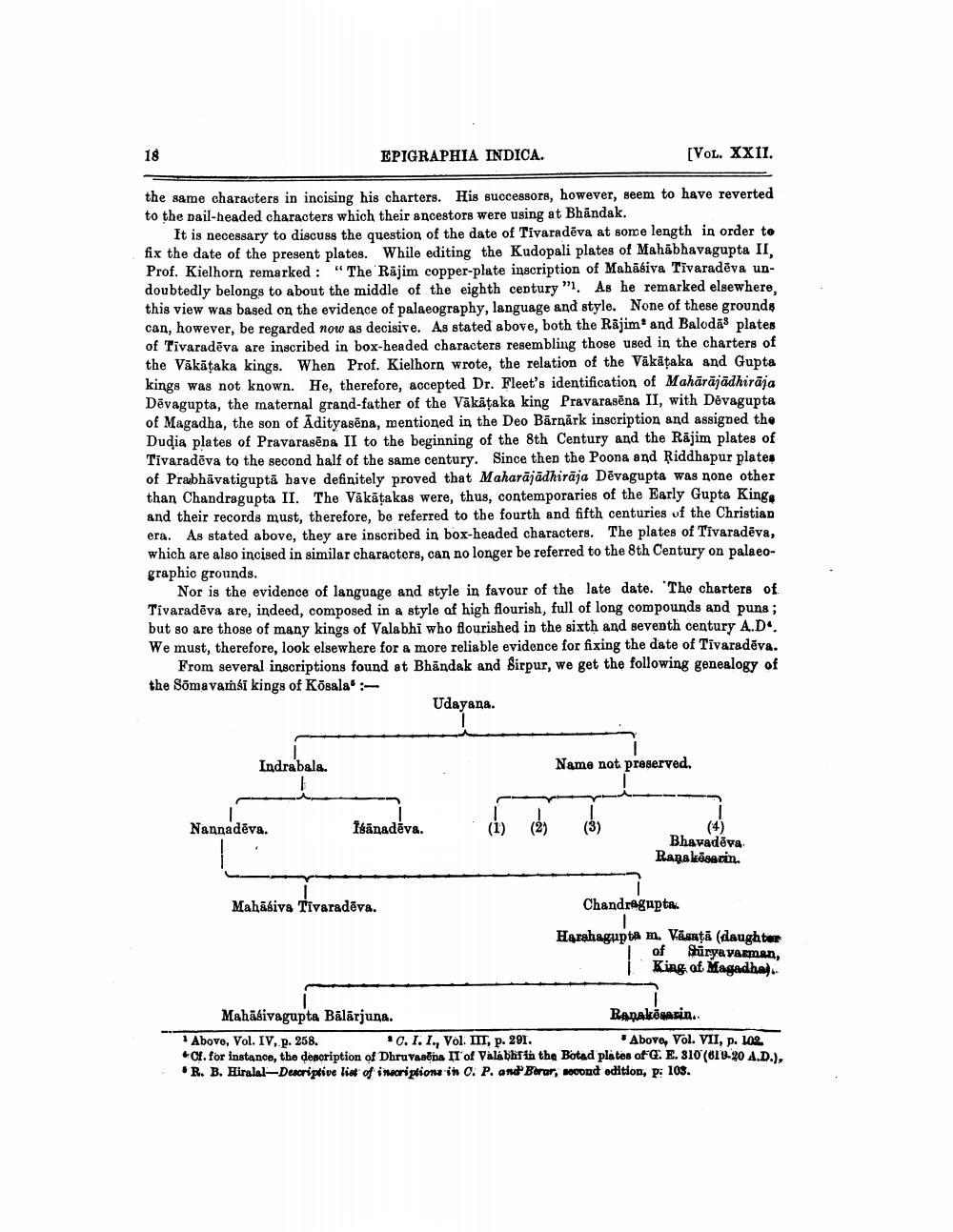________________
EPIGRAPHIA INDICA.
[VOL. XXII.
the same characters in incising his charters. His successors, however, seem to have reverted to the nail-headed characters which their ancestors were using at Bhāndak.
It is necessary to discuss the question of the date of Tivaradēva at some length in order to fix the date of the present plates. While editing the Kudopali plates of Mahābhavagupta II, Prof. Kielhorn remarked: "The Rajim copper-plate inscription of Mahasiva Tīvaradēva undoubtedly belongs to about the middle of the eighth century". As he remarked elsewhere, this view was based on the evidence of palaeography, language and style. None of these grounds can, however, be regarded now as decisive. As stated above, both the Räjim and Balodās plates of Tivaradēva are inscribed in box-headed characters resembling those used in the charters of the Vākātaka kings. When Prof. Kielhorn wrote, the relation of the Vākāțaka and Gupta kings was not known. He, therefore, accepted Dr. Fleet's identification of Mahārājādhirāja Dēvagupta, the maternal grand-father of the Vākāțaka king Pravarasēna II, with Dėvagupta of Magadha, the son of Adityasēna, mentioned in the Deo Bārnārk inscription and assigned the Dudia plates of Pravarasēpa II to the beginning of the 8th Century and the Räjim plates of Tivaradeva to the second half of the same century. Since then the Poona and Riddhapur plates of Prabhāvatiguptā have definitely proved that Maharājādhiraja Dēvagupta was none other than Chandragupta II. The Vākāțakas were, thus, contemporaries of the Early Gupta King. and their records must, therefore, be referred to the fourth and fifth centuries of the Christian era. As stated above, they are inscribed in box-headed characters. The plates of Tivaradēva, which are also incised in similar characters, can no longer be referred to the 8th Century on palaeographic grounds.
Nor is the evidence of language and style in favour of the late date. The charters of Tivaradēva are, indeed, composed in a style of high flourish, full of long compounds and pune; but so are those of many kings of Valabhi who flourished in the sixth and seventh century A.D. We must, therefore, look elsewhere for a more reliable evidence for fixing the date of Tivaradēva.
From several inscriptions found at Bhandak and Sirpur, we get the following genealogy of the Sõmavamsi kings of Kõsala -
Udауада.
Indrabala.
Name nat preserved.
Nannadēva.
Itānaděva.
(1) (2)
(2)
(3)
Bhavadēva Rapa kiserin.
Mahāśiva Tivaradēva.
Chandragupta.
Harshagupta m. Vasaţă (daughter
of Suryavarmen, 1 King of Magadha).
Mahāśivagupta Bālārjuna.
Ranakēnasin.. 1 Above, Vol. IV, p. 258. 10.I.I., Vol. II, p. 291.
Abovo, Vol. VII, p. 102 .ax. for instance, the description of Dhruvanna II of Valábhria the Botad plates of G. E. 310 (811-20 A.D.).
R. B. Hiralal-Descriptive line of incriptions in O. P. and Berar, sond edition, P: 103.




